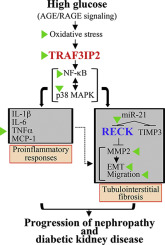当前位置:
X-MOL 学术
›
Cell. Signal.
›
论文详情
Our official English website, www.x-mol.net, welcomes your feedback! (Note: you will need to create a separate account there.)
Empagliflozin reduces high glucose-induced oxidative stress and miR-21-dependent TRAF3IP2 induction and RECK suppression, and inhibits human renal proximal tubular epithelial cell migration and epithelial-to-mesenchymal transition.
Cellular Signalling ( IF 4.8 ) Pub Date : 2019-12-17 , DOI: 10.1016/j.cellsig.2019.109506 Nitin A Das 1 , Andrea J Carpenter 1 , Anthony Belenchia 2 , Annayya R Aroor 3 , Makoto Noda 4 , Ulrich Siebenlist 5 , Bysani Chandrasekar 6 , Vincent G DeMarco 7
Cellular Signalling ( IF 4.8 ) Pub Date : 2019-12-17 , DOI: 10.1016/j.cellsig.2019.109506 Nitin A Das 1 , Andrea J Carpenter 1 , Anthony Belenchia 2 , Annayya R Aroor 3 , Makoto Noda 4 , Ulrich Siebenlist 5 , Bysani Chandrasekar 6 , Vincent G DeMarco 7
Affiliation

|
Proximal tubular epithelial cells (PTEC) in the S1 segment of the kidney abundantly express sodium-glucose co-transporters (SGLT) that play a critical role in whole body glucose homeostasis. We recently reported suppression of RECK (Reversion Inducing Cysteine Rich Protein with Kazal Motifs), a membrane anchored endogenous MMP inhibitor and anti-fibrotic mediator, in the kidneys of db/db mice, a model of diabetic kidney disease (DKD), as well as in high glucose (HG) treated human kidney proximal tubule cells (HK-2). We further demonstrated that empagliflozin (EMPA), an SGLT2 inhibitor, reversed these effects. Little is known regarding the mechanisms underlying RECK suppression under hyperglycemic conditions, and its rescue by EMPA. Consistent with our previous studies, HG (25 mM) suppressed RECK expression in HK-2 cells. Further mechanistic investigations revealed that HG induced superoxide and hydrogen peroxide generation, oxidative stress-dependent TRAF3IP2 upregulation, NF-κB and p38 MAPK activation, inflammatory cytokine expression (IL-1β, IL-6, TNF-α, and MCP-1), miR-21 induction, MMP2 activation, and RECK suppression. Moreover, RECK gain-of-function inhibited HG-induced MMP2 activation and HK-2 cell migration. Similar to HG, advanced glycation end products (AGE) induced TRAF3IP2 and suppressed RECK, effects that were inhibited by EMPA. Importantly, EMPA treatment ameliorated all of these deleterious effects, and inhibited epithelial-to-mesenchymal transition (EMT) and HK-2 cell migration. Collectively, these findings indicate that hyperglycemia and associated AGE suppress RECK expression via oxidative stress/TRAF3IP2/NF-κB and p38 MAPK/miR-21 induction. Furthermore, these results suggest that interventions aimed at restoring RECK or inhibiting SGLT2 have the potential to treat kidney inflammatory response/fibrosis and nephropathy under chronic hyperglycemic conditions, such as DKD.
中文翻译:

Empagliflozin降低高葡萄糖诱导的氧化应激和miR-21依赖性TRAF3IP2诱导和RECK抑制,并抑制人肾近端肾小管上皮细胞迁移和上皮向间充质转化。
肾脏S1节中的近端肾小管上皮细胞(PTEC)大量表达钠葡萄糖共转运蛋白(SGLT),这在全身葡萄糖体内稳态中起关键作用。我们最近报道了在db / db小鼠的肾脏(一种糖尿病性肾脏疾病(DKD)模型)的肾脏中抑制RECK(具有Kazal母体的还原诱导半胱氨酸富集蛋白),一种膜锚定的内源性MMP抑制剂和抗纤维化介质。如在高葡萄糖(HG)处理的人肾近端肾小管细胞(HK-2)中一样。我们进一步证明了SGLT2抑制剂依帕列净(EMPA)可以逆转这些作用。关于高血糖条件下RECK抑制的基本机制及其通过EMPA的挽救知之甚少。与我们以前的研究一致,HG(25 mM)抑制了HK-2细胞中RECK的表达。进一步的机理研究表明,HG诱导了超氧化物和过氧化氢的产生,氧化应激相关的TRAF3IP2上调,NF-κB和p38 MAPK活化,炎性细胞因子表达(IL-1β,IL-6,TNF-α和MCP-1), miR-21诱导,MMP2激活和RECK抑制。此外,RECK功能获得抑制了HG诱导的MMP2激活和HK-2细胞迁移。与HG相似,晚期糖基化终产物(AGE)诱导TRAF3IP2并抑制RECK,这种作用被EMPA抑制。重要的是,EMPA治疗改善了所有这些有害作用,并抑制了上皮到间质转化(EMT)和HK-2细胞迁移。这些发现共同表明,高血糖症和相关的AGE通过氧化应激/ TRAF3IP2 /NF-κB和p38 MAPK / miR-21诱导抑制RECK表达。
更新日期:2019-12-18
中文翻译:

Empagliflozin降低高葡萄糖诱导的氧化应激和miR-21依赖性TRAF3IP2诱导和RECK抑制,并抑制人肾近端肾小管上皮细胞迁移和上皮向间充质转化。
肾脏S1节中的近端肾小管上皮细胞(PTEC)大量表达钠葡萄糖共转运蛋白(SGLT),这在全身葡萄糖体内稳态中起关键作用。我们最近报道了在db / db小鼠的肾脏(一种糖尿病性肾脏疾病(DKD)模型)的肾脏中抑制RECK(具有Kazal母体的还原诱导半胱氨酸富集蛋白),一种膜锚定的内源性MMP抑制剂和抗纤维化介质。如在高葡萄糖(HG)处理的人肾近端肾小管细胞(HK-2)中一样。我们进一步证明了SGLT2抑制剂依帕列净(EMPA)可以逆转这些作用。关于高血糖条件下RECK抑制的基本机制及其通过EMPA的挽救知之甚少。与我们以前的研究一致,HG(25 mM)抑制了HK-2细胞中RECK的表达。进一步的机理研究表明,HG诱导了超氧化物和过氧化氢的产生,氧化应激相关的TRAF3IP2上调,NF-κB和p38 MAPK活化,炎性细胞因子表达(IL-1β,IL-6,TNF-α和MCP-1), miR-21诱导,MMP2激活和RECK抑制。此外,RECK功能获得抑制了HG诱导的MMP2激活和HK-2细胞迁移。与HG相似,晚期糖基化终产物(AGE)诱导TRAF3IP2并抑制RECK,这种作用被EMPA抑制。重要的是,EMPA治疗改善了所有这些有害作用,并抑制了上皮到间质转化(EMT)和HK-2细胞迁移。这些发现共同表明,高血糖症和相关的AGE通过氧化应激/ TRAF3IP2 /NF-κB和p38 MAPK / miR-21诱导抑制RECK表达。


























 京公网安备 11010802027423号
京公网安备 11010802027423号